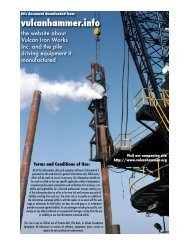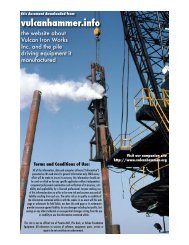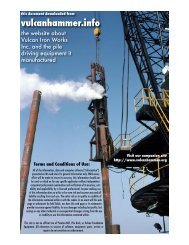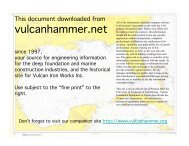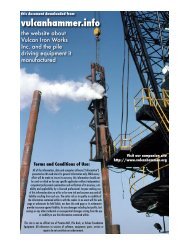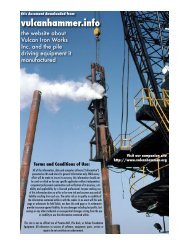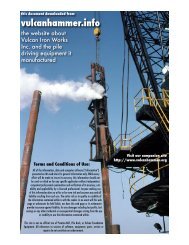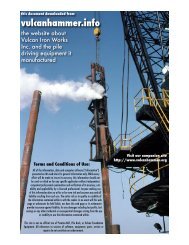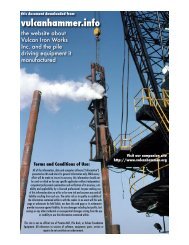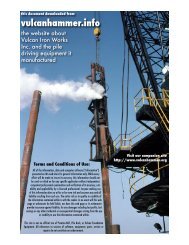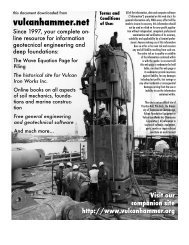Computer Study of Dynamic Behaviour of Piling - vulcanhammer.info
Computer Study of Dynamic Behaviour of Piling - vulcanhammer.info
Computer Study of Dynamic Behaviour of Piling - vulcanhammer.info
Create successful ePaper yourself
Turn your PDF publications into a flip-book with our unique Google optimized e-Paper software.
this document downloaded from<strong>vulcanhammer</strong>.<strong>info</strong>the website aboutVulcan Iron WorksInc. and the piledriving equipment itmanufacturedTerms and Conditions <strong>of</strong> Use:All <strong>of</strong> the <strong>info</strong>rmation, data and computer s<strong>of</strong>tware (“<strong>info</strong>rmation”)presented on this web site is for general <strong>info</strong>rmation only. While everyeffort will be made to insure its accuracy, this <strong>info</strong>rmation should notbe used or relied on for any specific application without independent,competent pr<strong>of</strong>essional examination and verification <strong>of</strong> its accuracy, suitabilityand applicability by a licensed pr<strong>of</strong>essional. Anyone making use<strong>of</strong> this <strong>info</strong>rmation does so at his or her own risk and assumes any and allliability resulting from such use. The entire risk as to quality or usability <strong>of</strong>the <strong>info</strong>rmation contained within is with the reader. In no event will this webpage or webmaster be held liable, nor does this web page or its webmasterprovide insurance against liability, for any damages including lost pr<strong>of</strong>its, lostsavings or any other incidental or consequential damages arising from the useor inability to use the <strong>info</strong>rmation contained within.Visit our companion sitehttp://www.<strong>vulcanhammer</strong>.orgThis site is not an <strong>of</strong>ficial site <strong>of</strong> Prentice-Hall, Pile Buck, or Vulcan FoundationEquipment. All references to sources <strong>of</strong> s<strong>of</strong>tware, equipment, parts, service orrepairs do not constitute an endorsement.
4 14 August, 1963 ST -4. .!1: 4;:.:- :,I,': I"I' .,.,INTRODUCTIONThe study <strong>of</strong> behavior <strong>of</strong> piling has received considerable attention by investigatorsin the past. Much work has been directed toward establishingsimplified formulas, both empirical and semi-rational. It is generally recognizedthat none <strong>of</strong> these proves completely satisfactory for the broad spectrum<strong>of</strong> pile types, pile drivers, and soil conditions encountered in present-dayfoundation problems. For a discussion <strong>of</strong> pile formulas, in general, the readeris referred to the work <strong>of</strong> Robert D. chellisS4The purpose <strong>of</strong> the present paper is to examine recent developments in theuse <strong>of</strong> wave theory in the structural analysis <strong>of</strong> piling. In the work <strong>of</strong> smith5a major contribution has been made toward adapting the general theory <strong>of</strong>stress-wave propagation to the peculiar problems associated with piling. One<strong>of</strong> the major objections that has been raised against this approach is the needfor high-speed electronic computation in the practical application <strong>of</strong> the procedure.In the present paper, the writers endeavor to demonstrate that considerableuseful data can be developed through generalized parameter studies.Certain extensions and refinements to Smith's work are also described. It isemphasized that the present study is limited to structural behavior <strong>of</strong> pilingduring driving. An effort has not been made to correlate resistance to penetrationwith ultimate bearing capacity.D. V. 1saacs6 is thought to be the first '(1931) to note the occurrence <strong>of</strong>wave action in piling during driving. However, it is interesting to note that1saac ~odhunter andKarl pearson7 state that H. ~osele~8 in 1843 gives driving<strong>of</strong> piles as a special application <strong>of</strong> impact and resilience theory.In 1938, W. H. Glanville, G. Grime, E. N. Fox, and W. W. ~aviesg publishedthe results <strong>of</strong> extensive mathematical and experimental studies <strong>of</strong> piling inwhich stress-wave propagation was considered. Because <strong>of</strong> limited computationalcapability at that time, the application <strong>of</strong> wave theory necessarily involvedsimplifying assumptions. Nevertheless, this work has considerablevalue. In 1940 A. E. ~umrnin~slo examined dynamic pile-driving formulas,in general, and provided a brief description <strong>of</strong> the wave-theory approach andthe theoretical work <strong>of</strong> Glanville and his associates.-4 UPile Foundations," by Robert D. Chellis, McGraw-Hill Book Co., Inc., New York,N. Y., 2d Ed., 1961.5 UPile-driving Analysis by the Wave Equation," by E. A. L. Smith, Transactions,ASCE, Vol. 127, 1962, Part I, p. 1145.6 "~e<strong>info</strong>rced concrete ~iie Formulae,' by D. V. Isaacs, Transactions, Institution<strong>of</strong> Engineers, Australia, Vol. 12, 1931, p. 312.7 'A History <strong>of</strong> the Theory <strong>of</strong> Elasticity," by Isaac Todhunter and Karl Pearson,Dover Publications, Inc., New York, N. Y., Vol. 1, 1960, p. 669.8 uThe Mechanical Principles <strong>of</strong> Engineering and Architecture,# by H. Moseley,London, 1843, pp. 598-603.9 UAn Investigation <strong>of</strong> the Stresses inRe<strong>info</strong>rced Concrete Piles during Driving,' byW. H. Glanville, G. Grime, E. N. Fox, and W. W. Davies, British Building ResearchBoard Technical Paper No. 20, Dept. <strong>of</strong> Scientific and Industrial Research, His Majesty'sStationery Office, London, 1938.10 "<strong>Dynamic</strong> Pile Driving Formulas,' by A. E. Cummings, Journal <strong>of</strong> the BostonSociety <strong>of</strong> Civil Engineers, January, 1940.
ST 4 COMPUTER STUDY 415smith5 has adaptedwave theory in a more realistic manner to the actual conditionsmet in pile driving. He published considerable previous workll,l2,13leading to the development <strong>of</strong> his procedure.Notation. -The letter symbols adopted for use in this paper are definedwhere they first appear and are arranged alphabetically in the Appendix.THEORYWave Equation.-Thewave-theoryapproach to the problem does not involvea uformula" in the usual sense. The basis for the procedure is the classicalone-dimensional wave equationin which c represents the velocity <strong>of</strong> propagation <strong>of</strong> strain wave along barx is the direction <strong>of</strong> longitudinal axis; u represents the displacement<strong>of</strong> bar cross section in x direction; t denotes time; E is the modulus <strong>of</strong> elasticity<strong>of</strong> material; and p is the mass per unit volume <strong>of</strong> material.Wave theory as applied to problems <strong>of</strong> longitudinal wave transmission andimpact is investigated in detail by L. H. Donnell,l4 S. Timoshenko and J. N.Goodier,15 H. Kolsky,16 and H. N. Abramson, H. J. Plass, and E. A. Ripperger.17 Julius ~iklowitzl8 provides an extensive list <strong>of</strong> references on thebroad subject <strong>of</strong> elastic wave propagation.Smith's Idealization. -Fig. 1 illustrates the idealization <strong>of</strong> the pile systemsuggested by Smith. In general, the system is considered to be composed <strong>of</strong>[see Fig. l(a)] the following: 1. A ram, to which an initial velocity is impartedby the pile driver; 2. a capblock (cushioning material); 3. a pile cap;4. a cushion block (cushioning material); 5. a pile; and 6. the supporting me -dium, or soil. Fig. l(b) shows the idealizations for the various components<strong>of</strong> the actual pile. The ram, capblock, pile cap, cushion block, and pile arepictured as appropriate discrete weights and springs. The frictional soil resistanceon the side <strong>of</strong> thepile is represented by a series <strong>of</strong> side springs; the(= m);-11 "Pile Driving Impact," by E. A. L. Smith, Proceedings, Industrial ComputationSeminar, September, 1950, International Business Machines Corp., New York, N. Y.,1951 p. 44.la "Impact and Longitudinal Wave Transmission," by E. A. L. Smith, Transactions,ASME, August, 1955, p. 963.13 "What Happens When Hammer Hits Pile," by E. A. L. Smith, Engineering News-Record, McGraw-Hill Publishing Co., Inc., New York, N. y., September 5, 1957, p. 46.T~on~itudinal Wave Transmission and Impact," by L. H. Donnell, Transactions,ASME, Vol. 52, 1930, p. 153.15 "Theory <strong>of</strong> Elasticity," by S. Timoshenko and J. N. Goodier, McGraw-Hill BookCo., Inc., New York, N. Y., 2d Ed., 1951, p. 438.16 'Stress Waves in Solids," by H. Kolsky, Oxford Univ. Press, London, New York,N. Y., 1953.17 "Stress Wave Propagation in Rods and Beams," by H. N. Abramson, H. J. Plass,and E. A. Ripperger, ~dv-ances in Applied Mechanics, Vol. 5, Academic Press Inc.,New York. N. Y.. 1958. p. 111.18 "~ecent ~evelo~ments in Elastic Wave Propagation," by Julius Miklowitz, AppliedMechanics Reviews, Vol. 13, No. 12, December, 1960, p. 865.
416 August, 1963 ST 4point resistance is accounted for by a single spring at the point <strong>of</strong> the pile.The characteristics <strong>of</strong> these various components will be described in greaterdetail.Actual situations may deviate from that in Fig. 1. For example, a cushionblock might not be used or an anvil may be placed between the ram and capblock.Such cases are readily accommodated.(A) ACTUAL PILE (0) IDEALIZED PILEFIG. 1.-IDEA LIZATION OF A PILE FOR PURPOSE OF ANALYSISInternal Springs.-The ram, capblock, pile cap, and cushion block may ingeneral be considered to consist <strong>of</strong> "internal" springs, although in the representation<strong>of</strong> .Fig. l(b) the ram and the pile cap are treated as though rigid (areasonable assumption for many practical cases).Figs. 2 (a), 2 (b), 2(c), and 2(d) suggest different possibilities for representingthe load-deformation characteristics <strong>of</strong> the internal springs. In Fig. 2(a)the material is considered to experience no internal damping. In Figs. 2(b)and 2(d), the material is assumed to have internal damping according to thelinear relationships shown. In Fig. 2(c), loading and unloading are consid-
COMPUTER STUDY 4 17LOAD9(a) NO INTERNAL DAMPING(b) INTERNAL DAMPINGPRESENTLOADLOADACDEFORMATION(C) INTERNAL DAMPINGPRESENT(d) INTERNAL DAMPINGPRESENTFIG. 2.-LOAD-DEFORMATIONINTERNAL SPRINGSRELATIONSHIPS FORLOAD4/TL-Ru (m)0C ,DEFORMATIONE //A)DFIG. 3.-LOAD-DEFORMATION CHARACTER-ISTICS ASSUMED FOR SOIL SPRING M
418 August, 1963 ST 4ered to occur along a hysteresis loop. The assumption that should be madefor a given problem depends on the material and its known load-deformationbehavior under dynamic conditions. Future investigation will probably shedmore light on this subject and will indicate which <strong>of</strong> Figs. 2(a), 2(b), 2 (c), and2(d) is most realistic for a given case. Furthermore, other representationscan be incorporated if desired.External Springs.-The resistance to dynamic loading afforded by the soilin shear along the outer surface <strong>of</strong> the pile and in bearing at the point <strong>of</strong> thepile is not clearly understood. Future studies will perhaps provide more <strong>info</strong>rmationon this question. Fig. 3 shows the load-deformation characteristicsassumed for the soil in Smith's procedure, exclusive <strong>of</strong> damping effects. Thepath OABCDEFG represents loading and unloading in side friction. In the presentpaper, both side-friction and point-bearing forces are permitted to act onthe last pile segment. In this case, the point-bearing force must be preventedfrom exerting tension on the pile. Thus, loading and unloading would occuralong OABCFCB. smith5 follows a somewhat different approach in combiningpoint bearing and side friction.It is seen that the characteristics <strong>of</strong> Fig. 3 are defined essentially by thequantities "Qn and "Ru." "Qn is termed the quake and represents the maximumdeformation that may occur elastically. "Run is the ultimate ground resistance,or the load at which a spring behaves purely plastically.A load-deformation diagram <strong>of</strong> the sort <strong>of</strong> Fig. 3 may be established separatelyfor each spring. Thus,K '(m) = ---- Rdm)Q(m) ..................(2)in which K1(m) is the spring constant (during elastic deformation) for externalspring m.Basic Equations. -Eqs. 3 through 7 were developed by smith5:in which ( ) represents a functional designation; m denotes the element number;t denotes the time interval number; At is the size <strong>of</strong> time interval in - .seconds; ~(m,t) represents the compression <strong>of</strong> internal spring m in time intervalt, in inches; D(m,t) describes the displacement <strong>of</strong> element rn in timeinterval t, in inches; ~'(m,t) represents the plastic displacement <strong>of</strong> externalspring m in time interval. t, in inches; ~(m,t) is the force in internal spring min time interval t, in pounds; g represents the acceleration due to gravity, infeet per second squared; J(m) is the damping constant <strong>of</strong> soil at element m,
ST 4 COMPUTER STUDY 419in seconds per foot; K(m) is the spring constant associated with internal springm, in pounds per inch; Kt(m) is the spring constant associated with externalspring m, in pounds per inch; R(m,t) is the force exerted by external springm on element m in time interval t, in pounds; ~(m,t) represents the velocity<strong>of</strong> element m in time interval t, in feet per second; and W(m) is the weight <strong>of</strong>element m, in pounds. This notation differs slightly from that used by Smith.Also, Smith restricts the soil damping constant J and the quake Q to two valueseach, one for the point <strong>of</strong> the pile in bearing and one for the side <strong>of</strong> the pile infriction. Although present knowledge <strong>of</strong> the damping behavior <strong>of</strong> soils perhapsdoes not justify greater refinement, J and Q are treated herein as functions<strong>of</strong> m for the sake <strong>of</strong> generality.The use <strong>of</strong> a spring constant ~ (m) implies a load-deformation behavior <strong>of</strong>the kind shown in Fig. 2(a). For this situation, K(m) is the slope <strong>of</strong> the straightline. Smith develops special relationships to account for internal damping inthe capblock and the cushion block. He obtains the following equation for alternateuse with Eq. 5:in which e(m) is the coefficient <strong>of</strong> restitution <strong>of</strong> internal spring m; and C(rn,t),=denotes the temporary maximum value <strong>of</strong> ~(m,t). With reference to Fig. 1,Eq. 8 would be applicable in the calculation <strong>of</strong> the forces in internal springsm = 1 and m = 2 in the ranges ABC and DE in Fig. 2(d). The load-deformationrelationship characterized by Eqs. 5 and 8 is illustrated by the path OABCDE 0.For a pile cap or a cushion block no tensile forces can exist; consequently,only this part <strong>of</strong> the diagram applies. Interniittent unloading-loading is typifiedby the path ABC, established by control <strong>of</strong> the quantity c(m,t)rnax in Eq. 8.The slope <strong>of</strong> lines AB, BC, and DE depends on the coefficient <strong>of</strong> restitutione(m).The computations proceed as follows;1. The initial velocity <strong>of</strong> the ram is determined from the properties <strong>of</strong> thepile driver. Other time-dependent quantities are initialized at zero.2. Displacements ~(m,l) are calculated by Eq. 3. It is to be noted that~(1,0) is the initial velocity <strong>of</strong> the ram.3. Compressions ~(m,l) are calculated'by Eq. 4.4. Internal spring forces ~(m,l) are calculated by Eq. 5 or Eq. 8 as appropriate.5. External spring forces R(m,l) are calculated by Eq. 6.6. Velocities V(m,l) are calculated by Eq. 7.7. The cycle is repeated for successive time intervals.In Eq. 6 plastic deformation D1(m,t) for a given external spring followsFig. 3 and may be determined by speiial routines. For example, when D(m,t)is less than ~ (m), Dl (m,t) is zero; when ~(m,t) is greater than Q(m) along lineAB (see Fig. 3), ~'(rn,t) is equal to ~(q,t) - ~ (m).Smithnotes that Eq. 6produces no damping when ~(m,t) - D1(m,t) becomeszero. He suggests an alternate equation tobe used after ~(m,t) first becomes
42 0August, 1963equal to Q(m):R(m,t) = [D(m,t) - D1(m,t)] Kf(m) + ~ (m) K' (m) Q(m) V(m,t - 1) . . . (9)Care must be used to satisfy conditions at the head and point <strong>of</strong> the pile.Consider Eq. 5. When m = p, in which p is number <strong>of</strong> the last element <strong>of</strong> thepile, K(p) must be set equal to zero since there is no F(p,t) force (see Fig. 1).Also, at the point <strong>of</strong> the pile, the soil spring must be prevented from exertingtension on the pile point. In applying Eq. 7 to the ram (m = I), ~(0,t) shouldbe set equal to zero.For the idealization <strong>of</strong> Fig. 1, it is apparent that the spring associated with~(2) represents both the cushion block and the top element <strong>of</strong> the pile. It maybe obtained by the following equation:A more complete discussion <strong>of</strong> digital-computer programming details andrecommended values for various physical quantities are given by ~mith.5It may be noted that the wave equation (Eq. 1) does not appear explicitly inthe basic equations given for Smith's idealization. However, Eqs. 3-7 may becombined to produce a difference equation corresponding to Eq. 1 with resistanceincluded.APPLICATIONS AND EXTENSIONS OF THEORYGeneral. -The basic equations previously presented have been programmedfor use as an analytical tool both in practical engineering applications and alsoin research. As a means <strong>of</strong> describing certain extensions to the procedure aswell as illustrating its use in investigating the influence <strong>of</strong> various parameters,several situations have been studied. Fig. 4 identifies four different piles:piles I, III, and IV are prestressed concrete; pile I1 is a steel H-section. Foreach pile, different cases <strong>of</strong> soil resistance are considered.Application to Ideal Pile; Pile IStudies. -For purposes <strong>of</strong> comparing Smith'sprocedure with the .exact method <strong>of</strong> analyzing elastic bars, Pile I is considered.Two cases are treated: in the first, the point is free; in the second, the pointis fixed. It is noteworthy that exact solutions are feasible only for pile problemsinvolving special conditions <strong>of</strong> material properties and soil resistance.However, problems encountered in practice do not usually fall into this category.The following <strong>info</strong>rmation, in addition to that given in Fig. 4, is applicableto the Pile I studies: W(ram) = 11,500 lb; ~(ram,O) = 14.45 ft per sec; K(cushionblock) = 3,930,000 lb per in.; and e(cushion block) = 1.00.Figs. 5 and 6 show ,stress versus time plots at the mid-length <strong>of</strong> the pilefor free and fixed end conditions, respectively. Solutions have been obtainedfor the exact solution <strong>of</strong> the one-dimensional wave equation (Eq. 1) and forSmith's discrete-element method using ten, twenty, and forty pile segments.The term "exact" as used here refers to the direct solution <strong>of</strong> Eq. 1. The
ST 4 COMPUTER STUDY 42 1CASE(RESISTANCE +DISTRIBUTION)I2345EIILAREA = 489 1NfPlLE LENGTH = 90FTMOD. OF ELASTICITY5 XIO' PSIAREA = 15.58 IN?PlLE LENGTH. 100 FTFREE-FIXED- 0MOD. OF ELAS~R~ITY= a o x l o 6 p s ~2 00100100LmAREA = 302.97 IN.PlLE LENGTH = 90FTrr)MOD. OF ELASTICITY'= 4.95 X 10' PSI 150 150 150. I50PL 18'9EmAREA = 269.1 IN!PlLE LENGTH = 95 FTMOD. OF E$ASTICITY= 8.18 X 10 PSI3 8NOTE:NUMERICAL VALUES INDICATTOTAL POINT AND SIDE RfSISTANCES IN KIPS, DlSTRlBUTAS SHOWN.FIG. 4.-PILES AND ULTIMATE SOIL RESISTANCES USEDIN STUDIES
August, 1963 ST 41000.2000-- EXACT0--- I0 SEGMENT PlLED---~O-SEGMENT PlLEA---40 SEGMENT PlLEAt = 1 /10,000 SECOND3000-FIG. 5.-STRESS AT MID-LENGTH OF PILE IWITH END FREE6'Wizcn-ZWI-3000'FIG. 6.-STRESS AT MID-LENGTH OF PILE I WITH END FIXED
ST 4 COMPUTER STUDY 42 3value <strong>of</strong> At used for allsmith's solutions is 1/ 10,000 sec. It is interesting tonote how increasing the number <strong>of</strong> pile segments improves the accuracy <strong>of</strong> thediscrete-element solution, as might be expected.The accuracy <strong>of</strong> the discrete-element solution is also related to the size<strong>of</strong> the time increment At. W. P. Heising,lg in his discussion <strong>of</strong> the equation<strong>of</strong> motion for free longitudinal vibrations in a continuous elastic bar, pointsout that the discrete-element solution is an exact solution <strong>of</strong> the partial differentialequation whenin which AL is the segment length. smith12 draws a similar conclusion. Figs.7 and 8 show comparisons <strong>of</strong> maximumtensile stress andmaximum compressivestress, respectively, versus position along the length <strong>of</strong> the pile for variousincrements <strong>of</strong> time. These solutions use a segment length <strong>of</strong> 9 ft. If atime increment larger than that given by Eq. 11 is used, the discrete-elementsolution will diverge and no valid results can be obtained. As noted by Smith,in this case the numerical calculation <strong>of</strong> the discrete-element stress wavedoes not progress as rapidly as the actual stress wave. Consequently, thevalue <strong>of</strong> At given by Eq. 11 is called the "critical" value.~eisin~l~ has also noted that when At < A L / is ~ used in a discreteelementsolution, a less accurate solution is obtained for the continuous bar.As At becomes progressively smaller, the solution approaches the actual behavior<strong>of</strong> the discrete-element system (segment lengths equal to AL) used tosimulate the pile.This in general leads to aless accurate solution for the longitudinal vibrations<strong>of</strong> a slender continuous bar. If, however, the discrete-element systemwere divided into a large number <strong>of</strong> segments, the behavior <strong>of</strong> this simulatedpile would be essentially the same as that <strong>of</strong> the slender continuous bar irrespective<strong>of</strong> how small At becomes provided A L / 7 ~ At > 0. This meansthat if the pile is divided into only a few segments, the accuracy <strong>of</strong> the solutionwill be more sensitive to the choice <strong>of</strong> At than if it is divided into manysegments. For practical problems, a choice <strong>of</strong> At equal to approximately onehalfthe "critical" value appears suitable because inelastic springs and materials<strong>of</strong> different densities and elastic moduli are usually involved.Figs. 9 and 10 show comparisons <strong>of</strong> maximum tensile stress and maximumcompressive stress, respectively, versus position along the length <strong>of</strong>Pile I (point free) for various time increments. Figs. 11 and 12 show comparisons<strong>of</strong> maximum tensile stress and maximum compressive stress, respectively,versus position along the length <strong>of</strong> Pile I (point fixed) for ten,twenty, and forty segments.Effect <strong>of</strong> Gravity.-The procedure as presented by Smtih5 does not accountfor the static weight <strong>of</strong> the pile. In other words, at t = 0 all springs,both internal and external, exert zero force. Stated symbolically, F(~,O) =R(~,O) = 0. If the effect <strong>of</strong> gravity is to be included, these forces must begiven initial values to produce equilibrium <strong>of</strong> the system. Strictly speaking,these initial values should be those in effect as a result <strong>of</strong> the previous blow.19 Discussion by W. P. Heising <strong>of</strong> 'Impact and Longitudinal Wave Transmis~ion,~by E. A. L. Smith, Transactions, ASME, August, 1955, p. 963.
August, 1963-EXACT0---At = 1/1410 SECOND = (At)cr'rnn0---At = l/2500 SECONDA--- At = I/ 5000 SECOND- zIDENTICAL RESULTS WERE OBTAINED4000-V)V)WFOR THE FOLLOWING VALUES OF At:1/5000, 1/10,0OO,AND 1/20,000SECOND.aL AL = PILE LENGTH / I 0-/HEAD OF PILE (FREE POINT OF PILE (FIXED)0i0 10 20 30 40 50 60 70 80 90DISTANCEFROM HEAD OF PlLE IN FEETFIG. 7.-MAXIMUM TENSILE STRESS ALONG PILE I, CASE 2- qEXACT 0- 5000-U) 0---At= 1 /I410 SECOND = (At),,nO---At = 1 /2500 SECONDzIDENTICAL RESULTS WERE OBTAINED2 4000- FOR THE FOLLOWINO VALUES OF At:W1/2500, 1/5000, 1/10,000, ANDa 1/20,000 SECOND.I-V) AL = PILE LENGTH / I09 3000 --qa 0U)0 0V)WK$2000-00I31000-X J HEAD OF PILE (FREE) POINT OF PlLE (FIXED)-aIDISTANCE FROM HEAD OF PlLE IN FEETFIG. 8.-MAXIMUM COMPRESSIVE STRESS ALONG PILE I, CASE 2
ST 4 COMPUTER STUDY 42 7Not only would it be awkward to ukeep books" on the pile throughout the drivingso as to identify the initial conditions for successive blows, but it is highlyquestionable that this refinement would be justified in light <strong>of</strong> other uncertainitiesthat exist.Two methods have beendeveloped as a means <strong>of</strong> entering the gravity effectinto the computations. The first <strong>of</strong> these has been proposed by ~mith;aO thesecond has been developed by the writers. Both will be described and compared.Smith's Approximate Method. -Smith suggests that the external (soil) springsbe assumed to resist the static weight <strong>of</strong> the system according to the relationshipin which W(tota1) is the total static weight resisted by soil, in pounds; andRu(tota1) is the total ultimate ground resistance, in pounds. The quantityW(tota1) is found byin which W(b) is the weight <strong>of</strong> the body <strong>of</strong> the hammer, excluding ram, inpounds; and ~ (c) is the force exerted by compressed gases, as under the ram<strong>of</strong> a diesel hammer, in pounds. The internal forces that initially exist in thepile may now be obtained:and in general,F(1,O) = W(b) + F(c) ................ (14)In the absence <strong>of</strong> compressed gases =d hammer weight resting on the pilesystem, the right side <strong>of</strong> Eq. 14 is zero. The amount that each internal springm is compressed may now be expressed asThe displacement <strong>of</strong> the point may be obtained fromBy working progressively upward from the point, other displacements aredetermined from* .20 Personal correspondence dated April 13, 1961, from E. A. L. Smith to CharlesH. Samson, Jr.
August, 1963
ST 4 COMPUTER STUDY 42 9For the inclusion <strong>of</strong> the gravity effect, Eq. 7 should be modified as follows:In order that the initial conditions <strong>of</strong> the external springs be compatiblewith the assumed initial forces R(~,O) and initial displacements D(m,O),plastic displacements D '(m,O) should be set equal to D(~,O) - ~(m,0)/ ~'(m).Influence -coefiicient Methods. -A second approach that may be used is totreat the system as a statically indeterminate structure. The assumption ismade that all springs behave as though linearly elastic in supporting the staticweight. The influence-coefficient method21 will be determined here as onemeans <strong>of</strong> solving the problem. Fig. 13 illustrates the two parts to the solution.The particular solution is obtained for the statically determinate structure(primary structure) formed by cutting all external springs except thelast and by loading with the applied loads W1, W2, etc. In this particulardiscussion, subscripts will be used as a convenience in place <strong>of</strong> the functionaldesignation used in other sections <strong>of</strong> the paper. The displacements for thevarious elements <strong>of</strong> this loaded structure are denoted by D10, D20, . . .Dm0, . . . and Dpo. In the formulation <strong>of</strong> the complementary solution, influencecoefficients dll, dl2 . . . dpp are generated by successively applyingunit loads (positive downward) at points 1, 2, . . . p on the primary structure.For example, dl2 is the deflection at point 1 caused by a unit load at point 2.Correspondingdisplacements causedby R1, R2, . . . Rp can now be expressedin terms <strong>of</strong> influence coefficients. For example, the complete equation for theactual displacement at a point m may be stated asBy considering the external spring at m as a free body, the following is obtained:Substituting from Eq. 2 1 into Eq. 20 producesSimilar equations may be obtained for the other points <strong>of</strong> redundancy.Using matrix notation for a concise representation <strong>of</strong> the series <strong>of</strong> equationstypified by Eq. 22 yields21 "Frame Analysis," by Arthur S. Hall and Ronald W. Woodhead, John Wiley & Sons,Inc., New York, N. Y., 1961.
430August, 1963in whichand1Considering that [dl, [I/ K' 1, and \D~/ are known, the solution for {R} may beobtainedbypremultiplyingboth sides <strong>of</strong> Eq. 23 by the inverse <strong>of</strong> ([dl + [l/K1]);
ST 4 COMPUTER STUDY 43 1thus,Of course, any method for solving the set <strong>of</strong> simultaneous equations implicitin Eq. 23 is satisfactory. However, the matrix formulation <strong>of</strong> Eq. 28 is quitesuitable for digital-computer solution.The solutions for {DO) and [dl are both associated with a statically determinatesystem [see Figs. 13(b) and 13(c)]. They may be found by the followingexpressions:I1 for i=n.......in Eq. 30 with W. =dmn = D m ~(31)1 0 for ifnIt is seen that computations may proceed from the point upward for all displacementquantities for the particular and complementary solutions. Forsimplification, i is considered to begin with i = 1. This, <strong>of</strong> course, must beadjusted to a particular pile problem to exclude the ram and any other elementsnot having side springs.At this stage, returning to the previous notation, all R(m,O) values .may beestablished by Eq. 28. Furthermore, by Eq. 21 all ~(m,0) values may be obtained.Compressions C(m,O) may be determined byForces F(m,O) are now found fromEq. 19 again provides the modified general velocity equation and computationsmay now proceed in the usual manner.Pile IIStudies. - Pile I1 is identified in Fig. 4. These studies are concernedwith the effects <strong>of</strong> gravity, time interval magnitude, and segment length. Allcalculations associated with this pile were performed on the basis <strong>of</strong> the followinggiven data: Q(m) = 0.1 in. for all m; ~(m) = 0.05 sec per ft for m f p;~(p) = 0.15 sec per ft; W(ram) = 5,000 lb; W(pi1e cap) = 700 lb; c cap block) =2 x 106 lb per in.; e(capb1ock) = 0.50; and V(1,O) = 12.4 ft per sec. A specialpile pointweighing 100 lb is assumed. Various cases <strong>of</strong> loading are identifiedin Fig. 4. A total ground resistance, Ru(tota1, <strong>of</strong> 200,000 lb) is used in eachcase. Other details concerning Pile I1 are given in Fig. 4.
August, 1963TIME IN MILLISECONDS0--GRAVITY EFFECTS EXCLUDED0--GRAVITY EFFECTS l NCLUDEDFIG. 14.-VARIATION OF POINT DISPLACEMENT WITH TIME: PILE 11, CASE 10-- GRAVITY EFFECTS EXCLUDED0-- GRAVITY EFFECTS INCLUDEDFIG. 15.-VARIATION OF POINT DISPLACEMENT WITH TIME: PILE 11, CASE 4
ST 4 COMPUTER STUDY 433Fig. 14 is a plot <strong>of</strong> point displacement versus time for Pile 11, Case 1. Theupper curve represents the solution with the gravity effect ignored. The lowercurve represents the solution including gravity effects obtainedboth by Smith'sapproximate method and by the influence-coefficient method; the differencescould not be plotted. Fig. 15 is a similar plot for Pile 11, Case 4. The greatesteffects <strong>of</strong> gravity are in the range <strong>of</strong> 5% to 10% for the plots shown.Figs. 16 and 17 are plots <strong>of</strong> midpoint stress versus time for PileII, Cases1 and 4, respectively. The gravity effect on stresses for these two cases issmall. It is <strong>of</strong> interest to note the comparison <strong>of</strong> R(m,O) values used in consideringPile 11, Case 4. Table 1 shows these values for gravity excluded, forSmith's approximate solution and for the influence-coefficient solution.Table 2 shows the effect <strong>of</strong> gravityon maximum compressive force, maximumtensile force, and the permanent set for all five cases <strong>of</strong> soil resistancefor Pile 11. The solutions with gravity included were obtained by the influencecoefficientmethod; however, they are quite similar to those found by Smith'sapproximate method.TABLE 1.-R(M,O)VALUESm345 >678910111Gravityexcluded000000000R(m,O), in poundsSmith'sapproximation -610610610610610610610610610- -Influence-coefficientsolution679.91651.70629.73612.87600.27591.26585.41582.39582.06Table 3 provides a comparison <strong>of</strong> maximum compressive forces and permanentset for various magnitudes <strong>of</strong> time intervals. For this case, the variationin results over the range <strong>of</strong> time intervals considered is small. For Pile11, the (~t),, for a segment length<strong>of</strong> 10 ft (ten segments) is 1/ 1,667 sec. Allresults thus far discussed for Pile II were obtained using a segment length <strong>of</strong>10 ft.Table 4 provides a comparison <strong>of</strong> maximum compressive forces at differentpositions along the pile for different magnitudes <strong>of</strong> time intervals anddifferent segment lengths. The results apply to Pile 11, Case 2. It is seenthat the forces compare closely at a given point on the pile.Pile III Studies.-The different resistance cases considered for Pile 111 aredefined in Fig. 4. These studies illustrate the influence <strong>of</strong> pile driver, cushionblock, and pile characteristics on pile behavior. The following data are used:Ram Weight.-W(A) = 4,850 lb; W(B) = 9,300 lb; and W(C) = 14,000 lb. Inthe case <strong>of</strong> ram A, two possibilities are examined: in the first it is assumedthat no explosive pressure exists beneath the ram; in the second it is assumedthat an explosive pressure <strong>of</strong> 158,700 lb is present. This simulates a pressurethat might be encountered in certain types <strong>of</strong> diesel hammers.
436 August, 1963 ST 4ICapblock. cap cap block) = 240 x 106 lb per in. and e(capblock) = 0.50.Pile Cap.-One pile is considered for all solutions. It is assumed to berigid with W(pi1e cap) = 1,150 lb.Cushion Block. -Two cushion blocks are considered, both assumed weightless.Stiffnesses are specifiedas follows: K(A) = 16.7 x 106 lbper in.; K(B) =167 x 106 lb per in.; and e(cushion block) = 1.00.Pile. -AL = 10 ft for each <strong>of</strong> 9 segments. Unless otherwise specified, amodulus <strong>of</strong> elasticity <strong>of</strong> 4.95 x 106 psi is assumed.Soil. -J(m) = 0.05 sec per ft for m f p; J(~) = 0.15 sec per ft; and ~(m) =0.10 in. for all m.Figs. 18, 19, 20, and 21 show plots <strong>of</strong> maximum tensile stiess developedin the pile versus ram velocityfor different ram weights anddifferent cushionblocks. The results for ram A are given withand without explosive pressure.Similar plots <strong>of</strong> maximum compressive stress developed in the pile versusram velocity are provided in Figs. 22, 23, 24, and 25.Although this study is <strong>of</strong> limited scope, it illustrates a way in which generalized<strong>info</strong>rmation can be presented. It is also <strong>of</strong> interest to appraise theparticular results obtained for the ranges <strong>of</strong> variables treated.For a given ram, as might be expected, both tensile and compressivestresses usually increase with velocity.In most cases, the effect <strong>of</strong> the stiffer cushion block is to produce higherteniile stresses. Minor exceptions may be noted for ram C in Figs. 18, 19,and 20. The influence <strong>of</strong> cushion-block stiffness on development <strong>of</strong> tensilestress is quite pronounced in some cases. For example, the stiffer cushionblock causes 59% greater tension velocity <strong>of</strong> 17.8 ft per sec, and Case 1 soilresistance.The effect <strong>of</strong> explosive pressure for the ranges <strong>of</strong> variables considereddoes not .appear marked. For example, for the Case 1 soil resistance, thes<strong>of</strong>t cushion block, and ram velocity <strong>of</strong> 17.8 ft per sec, the explosive pressureproduces a decrease <strong>of</strong> 7% in the maximum tensile stress developed.In order to gain <strong>info</strong>rmation concerning the effect <strong>of</strong> modulus <strong>of</strong> elasticity<strong>of</strong> the pile material, the combination <strong>of</strong> Case 1 soil resistance, ram A with noexplosive pressure, and stiff and s<strong>of</strong>t cushion blocks are considered for moduli<strong>of</strong> elasticity <strong>of</strong> 2.5 x 106 psi and 7.5 x 106 psi, in addition to the value <strong>of</strong> 4.95x 106 psi used in previous calculations. Figs. 26 and 27 illustrate the resultsin the form <strong>of</strong> maximum tensile stress and maximum compressive stress,respectively, versus ram velocity. At all velocities considered, both tensileand compressive stresses increase with increase in modulus <strong>of</strong> elasticity <strong>of</strong>the pile material.Comparison <strong>of</strong> Theoretical and Field Test Results; Pile IV Studies. -PileIV was field tested during the construction <strong>of</strong> the Nueces Bay Causeway atCorpus Christi, Tex. Stresses were recorded on a high-speed recording oscillograph.The variation <strong>of</strong> stress with time at a point 9.5 ft from the head <strong>of</strong>the pile is plotted in Figs. 28,29, and 30 as a basis for comparison with theory.The pile had penetrated 45 ft into a s<strong>of</strong>t marine silty-clay.The theoretical solutions for all three figures were obtained with the followingspecified <strong>info</strong>rmation: W(ram) = 4,850 lb and V(ram,O) = 13.8 ft persec. The gravity effect <strong>of</strong> the pile was neglected.The differences in the theoretical solutions result from the manner <strong>of</strong> accountingfor internal damping in the pile. In the theoretical solution <strong>of</strong> Fig.28, the pile material is considered to be perfectly elastic. In the solution
PILE m, CASE 2-V)aZO O -STIFF CUSHION BLOCKSOFT CUSHION BLOCK0 RAM A WlTH EXPLOSIVE PRESSURE5000-,4000 -RAM A WITHOUT EXPLOSIVEA RAM B0 RAM CPRESSURE- STIFF CUSHION BLOCK--- SOFT CUSHION BLOCK0-- RAM A WlTH EXPLOSIVE PRESSURE0--RAM A WITHOUT EXPLOSIVE PRESSUREA--RAM B1 &-RAM C0 010 I 2 14 16 18 20 22 24 10 12 14 16 18 20 22 24RAM VELOCITY IN FPS RAM VELOCITY IN FPSFIG. 18.-VARIATION OF MAXIMUM TENSILE STRESS WITH RAM FIG. 19.-VARIATION OF MAXIMUM TENSILE STRESSVELOCITY: PILE 111, CASE 1 WITH RAM VELOCITY: PILE 111, CASE 2
August, 196322% I-OOW 2111 I;:k k""3 3ISd NISS3tllS 311SN31 WflWIXQW
-XaH 1000-- STIFF CUSHION BLOCK--- SOFT CUSHION BLOCK0-- RAM A WITH EXPLOSIVE PRESSUREa-- RAM A WITHOUT EXPLOSIVE PRESSUREA-- RAM B0--RAMCPILE m, CASE 2- STIFF CUSHION BLOCK--- SOFT CUSHION BLOCK0--RAM A WITH EXPLOSIVE PRESSURE0--RAM A WITHOUT EXPLOSIVE PRESSUREA--RAM B0--RAMCRAM VELOCITY IN FPSRAMVELOCITY IN FPSFIG. 22.-VARIATION OF MAXIMUM COMPRESSIVE STRESSWITH RAM VELOCITY: PILE 111, CASE 1FIG. 23.-VARIATION OF MAXIMUM COMPRESSIVE STRESSWITH RAM VELOCITY: PILE 111, CASE 2
PILE 111. CASE 3- STIFF CUSHION BLOCK--- SOFT CUSHION BLOCK0--RAM A WlTH EXPLOSIVE PRESSURE0--RAMA--RAM B0--RAM cA WITHOUT EXPLOSIVE PRESSURE- STIFF CUSHION BLOCK--- SOFT CUSHION BLOCK0--RAM A WlTH EXPLOSIVE PRESSURE0--RAM A WITHOUT EXPLOSIVE PRESSUREA--RAM B0--RAM cRAM VELOCITY IN FPS10 12 14 16 18 20 22 24RAM VELOCITY IN FPSFIG. 24.-VARIATION OF MAXIMUM COMPRESSIVESTRESS WITH RAM VELOCITY: PILE 111,CASE 3FIG. 25.-VARIATION OF MAXIMUM COMPRESSIVESTRESS WITH RAM VELOCITY: PILE 111,CASE 4
-f6000 -5000--STIFF CUSHION BLOCK-- SOFT CUSHION BLOCK0--E = 2.5 X 10' PSI0--E = 4.95 x 10' PSIA--~t 7.5 x 10' PSI- STIFF CUSHION BLOCK-- SOFT CUSHION BLOCK0--E = 2.5 X 10' PSI0-- E = 4.95 X 10' PSIA-- E = 7.5 x 10' PSIRAM VELOCITY IN FPS0 I14 16 18 20 2 2 2 4RAM VELOCITY IN F P SFIG. 26.-INFLUENCE OF MODULUS OF ELAS-TICITY ON MAXIMUM TENSILE STRESS:PILE 111, CASE 1FIG. 27.-INFLUENCE OF MODULUS OF ELAS-TICITY ON MAXIMUM COMPRESSIVESTRESS: PILE 111. CASE 1
1200 1TIME IN MILLISECONDS1 TIME IN MILLISECONDSFIG. 28.-COMPARISON OF THEORETICAL AND TEST RE-SULTS: PILE IV WITH NO INTERNAL DAMPING(e = 1.0 AND B = 0.0)FIG. 29.-COMPARISON OF THEORETICAL ANDTEST RESULTS: PILE IV WITH IN-TERNAL DAMPING (e = 0.8)
COMPRESSIVE STRESSIN PSITENSILEINSTRESSPSIIele0M M O$28zszzmoz " '4-'%;~ L MI1 0?zgz l-3~ $ 5-e>z t'COMPRESSIVE STRESSIN PSITENSILE STRESSIN PSIEPP
444 August, 1963 ST 4shown in Fig. 29, a load-deformation relationship <strong>of</strong> the form <strong>of</strong> Fig. 2(b) isassumed in which the coefficient <strong>of</strong> restitution is 0.8. Although there is noparticular justification for this specific shape, it does serve to provide adifferent internal load-deformation behavior by which internal damping occurs.LOADfFIG. 32.-SEGMENT OF A TYPICAL LOAD-DEFORMA-TION CURVE OBTAINED BY EQ. 34smith5 has proposed another means <strong>of</strong> accounting for internal damping.In place <strong>of</strong> Eq. 5 Smith suggestsin which B(m) is a damping constant for internal spring m. Smith states thata value <strong>of</strong> B <strong>of</strong> approximately 0.0002 in. sec per ft will produce a narrow ,
ST 4 COMPUTER STUDY 44 5STRESS IN SEGMENT NL)FB€R 5 VS. I TERATION 'NUKLEHFIG. 33.-COMPUTER-PLOTTEDVALUES OF STRESS VERSUS TIME INTERVAL
446 August, 1963 ST 4hysteresis loop. Of course, the value can be adjusted to approximate a knownmaterial behavior. By using Eq. 34 and a value <strong>of</strong> B = 0.0016 in. sec per ft,the theoretical curve <strong>of</strong> Fig. 30 is obtained. The load-deformation diagram isshown in Fig. 2(c). By comparing the theoretical solutions with test results,a reasonably good correlation is seen over some ranges. In light <strong>of</strong> the limited<strong>info</strong>rmation available concerning the dynamic behavior <strong>of</strong> soil, the writersconsider the correlations to be encouraging. In order to compare directly thethree theoretical solutions, Fig. 3 1 is provided.A series <strong>of</strong> hysteresis loops taken from aproblem involving Eq. 34 is shownin Fig. 32. At the present stage <strong>of</strong> development, Eq. 34 appears to <strong>of</strong>fer themost realistic means <strong>of</strong> simulating the internal damping characteristics. Theload-deformation relationship <strong>of</strong> Fig. 2(d) has been suggested by smith22 asanother possible means <strong>of</strong> accounting for internal damping. However, nosolutions have been obtained using this type <strong>of</strong> diagram.Automatic Plotting by <strong>Computer</strong>. - With solutions <strong>of</strong> the type obtained bythe wave -theory program, graphical representations <strong>of</strong> results are <strong>of</strong>ten desirable.Fig. 33 is providedin order to illustrate the automatic plotting capability<strong>of</strong> the digital computer. The particular plot given corresponds to thetheoretical solution <strong>of</strong> Fig. 28. A dashed line has been sketched through theasterisk points provided by the computer.CONCLUSIONSAlthough the investigation was not intended to provide a comprehensiveparameter study, it is possible to make certain observations with respect tothe data presented, as long as the scope <strong>of</strong> such observations is restricted tothe ranges <strong>of</strong> variables considered.On the basis <strong>of</strong> the present investigation, the writers have formed the followingconclusions:1. In the studies presented, good numerical accuracy was obtained bydividing piles into at least ten segments with no segment length exceeding 10ft and keeping the time interval less than one-half the critical value. Forrelatively short piles, the number <strong>of</strong> segments can likely be decreased. Itshould also be noted that the maximum time interval may be controlled byconditions such as a steel ram striking a stiff capblock.2. For the cases considered, the gravity effect does not appear severeas far as compressive stresses and permanent sets are concerned. Its influenceon tensile stresses can prove significant, however, for prestressed concretepiles.3. For the limited number <strong>of</strong> cases in which the gravity effect was considered,there were no significant differences obtained by Smith's approximatemethod or the influence-coefficient method. However, a much widerrange <strong>of</strong> conditions needs to be studied before any general conclusioncan bereached.4. The influence <strong>of</strong> explosive pressure on results does not appear pronounced.22 Personal correspondence dated December 15, 1962, from E. A. L. Smith toCharles H. Samson, Jr.
ST 4 COMPUTER STUDY 4475. The velocity <strong>of</strong> the ram is <strong>of</strong> primaryimportance in the magnitudes <strong>of</strong>stresses developed.6. The modulus <strong>of</strong> elasticity <strong>of</strong> the pile material is significant with respectto stresses produced.7. Wave theory as applied to stress propagation <strong>of</strong>fers a rational approachto the problems associated with the structural behavior <strong>of</strong> piling. It appearsthat all the significant factors may be provided for.8. The increasing availability <strong>of</strong> high-speed digital computers to the engineeringpr<strong>of</strong>ession should make the wave-theory approach more attractive.Future improvements and developments in computer technology will add to theadvantages <strong>of</strong> the procedure.9. Through generalized parameter studies much useful <strong>info</strong>rmation maybe generated for use by the practicing engineer. It should be possible to developapproximate Urules-<strong>of</strong>-thumbVor use in determining favorable drivingconditions. For example, with a given prestressed concrete pile and a giventype <strong>of</strong> soil, it is <strong>of</strong> interest to know what hammer characteristics would bemost favorable with respect to drivingwhile avoiding excessive tensile stresses.10. Future work is especially needed to understand the dynamic behavior<strong>of</strong> soils and the internal damping characteristics <strong>of</strong> pile materials. Thisshould contribute greatly to obtaining closer agreement <strong>of</strong> theoretical and testresults.I . Research is neededto study the possibility <strong>of</strong> relating soil data and theresistance to penetration obtained by wave theory to the ultimate bearing capacity<strong>of</strong> the pile. As stated previously, it is not the intent <strong>of</strong> this paper toconsider this problem. However, it would seem logical that ultimate bearingcapacity would be in some way related to resistance to penetration and othersoil properties.12. Of particular interest are the high tensile stresses found for many <strong>of</strong>the cases studied. For prestressed concrete piles the implications are obvious,and the matter <strong>of</strong> the amount <strong>of</strong> tensile stress developed takes on greatsignificance in the design <strong>of</strong> the pile and in the specification <strong>of</strong> driving conditions.Certain practical aspects <strong>of</strong> this problem have been examined by G. C.Strobe1 and John ~eald,23 Charles H. Samson, ~r.,24 and Donovan H. ~ee.2513. It is <strong>of</strong> some interest to compare the rate <strong>of</strong> hammer blows with thetime required for atensilewave to be reflectedback for a long pile. As notedby ~amson,24 a rate <strong>of</strong> 105 blows per minute allows a time interval <strong>of</strong> 0.57sec between blows. Both the theoretical and test results <strong>of</strong> the present investigation(see Fig. 28) show that this time is well under 0.02 sec, or 1/28the time between blows. This would seem to show that, at least for piles <strong>of</strong>the length considered, successive blows cannot be relied on to reduce tensilestresses.23 "Theoretical and Practical Discussion <strong>of</strong> the Design, Testing and Use <strong>of</strong> PretensionedPrestressed Concrete <strong>Piling</strong>," by G. C. Strobe1 and John Heald, Journal, PrestressedConcrete Inst., Vol. 6, No. 3, September, 1961, p. 22.24 Discussion by Charles H. Samson, Jr. <strong>of</strong> "Theoretical and Practical Discussion<strong>of</strong> the Design,Testing and Use <strong>of</strong> Prestressed Concrete <strong>Piling</strong>," G. C. Strobe1 and JohnHeald, Journal, Prestressed Concrete Inst., Vol. 6, No. 3, September, 1961, p. 22.25 Discussion by Donovan H. Lee <strong>of</strong> 'Theoretical and Practical Discussion <strong>of</strong> theDe'sign, Testing and Use <strong>of</strong> Pretensioned Prestressed Concrete <strong>Piling</strong>," by G. C. Strobe1and John Heald, Journal, Prestressed Concrete Inst., Vol. 6, No. 3, September, 1961,p. 22.
448 August, 1963 ST 4ACKNOWLEDGMENTSThe wave-theory computer program and the field-test data used in this investigationwere obtainedas part <strong>of</strong> Research Projects RP-25 and RP-27, respectively,sponsored by the Bridge Division <strong>of</strong> the Texas Highway Department.Both projects were performed by the Texas Transportation Institute, A. & M.College <strong>of</strong> Texas. The writers gratefully acknowledge the assistance <strong>of</strong> FarlandC. Bundy, Supervising Design Engineer, Bridge Division, Texas HighwayDepartment, who worked closely with the writers in accomplishing both proj -ects, and D. D. Drew, Engineering Computation Specialist at the Data ProcessingCenter, A. & M. College <strong>of</strong> Texas, who directed and performed much <strong>of</strong> theprogramming. The writers also thank E. A. L. Smith, formerly Chief MechanicalEngineer for Raymond International Inc., and now retired, who maintaineda continuirig interest throughout the work and who contributed significantlyto the accomplishments <strong>of</strong> the research.This work has served as the basis for a current project being sponsoredjointly by the Bridge Division <strong>of</strong> the Texas Highway Department and the Bureau<strong>of</strong> Public Roads.APPENDIX. -NOTATIONB(m)The following symbols have been adopted for use in this paper:c(m,t)= damping constant for internal spring m, in inches;= compression <strong>of</strong> internal spring m in time interval t, in inches;C(m,t)max = temporary maximum value <strong>of</strong> ~(m,t), in inches;= velocity <strong>of</strong> propagation <strong>of</strong> stress wave;= displacement <strong>of</strong> element m in time interval t, in inches;= plastic displacement <strong>of</strong> external spring m in time interval t, ininches;= displacement influence coefficient;= modulus <strong>of</strong> elasticity;= coefficient <strong>of</strong> restitution <strong>of</strong> internal spring m;= force in element m in time interval t, in pounds;= acceleration due to gravity, in feet per second squared;= damping constant for soil at element m, in seconds per foot;= spring constant associated with internal spring m, in pounds perinch;= spring constant <strong>of</strong> external spring m, in pounds per inch;
= element number;= number <strong>of</strong> m at point <strong>of</strong> pile;COMPUTER STUDY 449= quake <strong>of</strong> external spring m, in inches;= force exerted by external spring m on element m in time intervalt in pounds;= ultimate ground resistance for external spring m, in pounds;= time, or time interval;= displacement <strong>of</strong> a bar cross section in x direction;= velocity <strong>of</strong> element m in time interval t, in feet per second;= weight <strong>of</strong> element m, in pounds; .= direction <strong>of</strong> longitudinal axis <strong>of</strong> a bar;= mass per unit volume;= length <strong>of</strong> segment;= size <strong>of</strong> time interval, in seconds;= size <strong>of</strong> critical time interval, in seconds;= functional designation;= rectangular matrii;= column matrix; and= inverse <strong>of</strong> a matrix.
KEY WORDS: computers; concrete, prestressed; foundations; piles; structural engineeringABSTRACT: The application <strong>of</strong> wave theory to the investigation <strong>of</strong> structural behavior<strong>of</strong> piling is examined. A digital-computer program based substantially on thework <strong>of</strong> Smith was used in generating the theoretical solution. The essentials <strong>of</strong>Smith's development are given, followed by an investigation <strong>of</strong> certain extensions andapplications <strong>of</strong> the procedure. It is illustrated how, through the use <strong>of</strong> high-speeddigital computation, the influence on pile behavior <strong>of</strong> factors such as ram weight, ramvelocity, diesel-hammer pressure, capblock and cushion-block stiffnesses, pile materialproperties, and soil properties may be evaluated. Comparisons are made withthe "exact" solution for an ideal bar and with experimental results from a field test.The effects <strong>of</strong> segment length and time interval for the discrete-element solution areexamined. The use <strong>of</strong> the automatic plotting capability <strong>of</strong> the digital computer isillustrated.REFERENCE: "<strong>Computer</strong> <strong>Study</strong> <strong>of</strong> <strong>Dynamic</strong> Behavior <strong>of</strong> <strong>Piling</strong>," by Charles H. Samson,Jr ., Teddy J. Hirsch, and Lee L. Lowery, Jr., Journal <strong>of</strong> the structural Division,ASCE, Vol. 89, No. ST4, Proc. Paper 3608, August, 1963, pp. 413-449.



